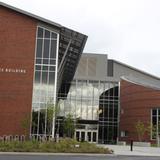- The mission of Clatsop Community College is to provide high quality learning opportunities for individuals in Clatsop County and beyond, and to lead in meeting the changing needs of our community.
School Highlights
Clatsop Community College serves 1,799 students (27% of students are full-time).
The college's student-teacher ratio of 14:1 is lower than the state community college average of 21:1.
Minority enrollment is 57% of the student body (majority Hispanic), which is more than the state average of 47%.
Quick Facts (2025-26)
- Enrollment: 1,799 students
- In-state tuition: $4,014
- Out-state tuition: $7,578
- Student-teacher ratio: 14:1
- Minority enrollment: 57%
- Source: Integrated Postsecondary Education Data System (IPEDS)
Top Rankings
Clatsop Community College ranks among the top 20% of public schools in Oregon for:
Category
Attribute
School Resources
School Overview
The teacher population of 129 teachers has stayed relatively flat over five years.
Clatsop Community College
(OR) Community College Avg.
Carnegie Classification
Associate's Colleges: High Transfer-High Nontraditional
Not applicable, not in Carnegie universe (not accredited or nondegree-granting)
Institution Level
At least 2 but less than 4 years
At least 2 but less than 4 years
Institution Control
Public
Private not-for-profit
Total Faculty
129 staff
192 staff
Student Body
The student population of Clatsop Community College has grown by 128% over five years.
The student-teacher ratio of 14:1 has increased from 6:1 over five years.
The Clatsop Community College diversity score of 0.65 is less than the state average of 0.66. The school's diversity has grown by 32% over five years.
Total Enrollment
1,799 students
2,463 students
Student-Teacher Ratio
14:1
21:1
# Full-Time Students
485 students
310 students
# Part-Time Students
1,314 students
2,153 students
# Enrollment Undergraduate
179 students
339 students
# Full-Time Undergraduate Students
485 students
310 students
# Full-Time Graduate Students
n/a
193 students
# Part-Time Undergraduate Students
1,314 students
2,589 students
# Part-Time Graduate Students
n/a
153 students
Total Dormitory Capacity
n/a
270 students
% American Indian/Alaskan
n/a
1%
% Asian
1%
5%
% Hispanic
14%
20%
% Black
1%
3%
% White
43%
53%
% Hawaiian
1%
1%
% Two or more races
2%
5%
% Non Resident races
n/a
1%
% Unknown races
38%
11%
Diversity Score
0.65
0.66
College Completion Rate (Students who graduate in less than 4 years)
15%
42%
College Completion Rate (Students who graduate in 4 years or more than 4 years)
n/a
58%
Average Graduate Earnings (10 Years)
$31,000
$33,800
Tuition and Acceptance Rate
The public in-state tuition of $4,014 is less than the state average of $4,172. The in-state tuition has declined by 5% over four years.
The public out-state tuition of $7,578 is more than the state average of $6,738. The out-state tuition has declined by 5% over four years.
In-State Tuition Fees
$4,014
$4,172
Out-State Tuition Fees
$7,578
$6,738
% Students Receiving Some Financial Aid
97%
79%
Median Debt for Graduates
$11,542
$12,875
Median Debt for Dropouts
$7,000
$6,334
Acceptance Rate
n/a
100%
Source: 2024 (or latest year available) Integrated Postsecondary Education Data System (IPEDS) , School Administrators
School Notes
- Clatsop Community College is a public, two-year institution serving northwest Oregon and southwest Washington since 1958. It has grown to an enrollment of over 7,000 students. Instruction and training in liberal arts and sciences, professional technical fields, continuing education, developmental education, and general education are offered. Located at the mouth of the Columbia River in historic Astoria, the College enjoys the mild climate that has helped make the Oregon coast famous for its lush, green beauty and rugged, undeveloped shoreline. Its high-quality, low-cost education serves a district that covers all of Clatsop County and part of Columbia County in Oregon, and Pacific and Wahkiakum Counties in Washington. In addition to the main campus facilities, the College has a performing arts center and waterfront Marine and Integrated Manufacturing Technology training facilities. The South County Center in Seaside serves south Clatsop County including the cities of Seaside, Gearhart, and Cannon Beach. Other communities which the College serves include Warrenton, Knappa, Clatskanie, Rainier, and Westport, as well as Long Beach, Ilwaco, Seaview, and Naselle in Washington. The degree offered by Clatsop Community College includes Associate of Arts - Oregon Transfer Degree, Associate of Science - Oregon Transfer Degree in Business, Associate of General Studies, Associate of Applied Science Degrees. The college also offers Applied Science Certificate Programs. Clatsop Community College is accredited by the Northwest Commission on Colleges and Universities.
Frequently Asked Questions
How much does Clatsop Community College cost?
Clatsop Community College's tuition is approximately $4,014 for In-State students and $7,578 for Out-State students.
What is Clatsop Community College's ranking?
Clatsop Community College ranks among the top 20% of community college in Oregon for: Percent of students receiving financial aid.
School Calendar
View the Clatsop Community College yearly calendar below. Note key dates such as:
Event
Date
Last Day to Change to an Audit/Credit or Withdraw
November 14, 2025 (Friday)
Last Day to Register for 2026 Winter Classes
January 05, 2026 (Monday)
Payment Due/Last Day to Drop a Course
January 12, 2026 (Monday)
Last Day to Change to an Audit/Credit or Withdraw
February 27, 2026 (Friday)
Last Day to Register for 2026 Spring Classes
March 30, 2026 (Monday)
Recent Articles

How to Transfer from Community College to a Four-Year University in 2025
A step-by-step guide for community college students transferring to a four-year university in 2025 — updated strategies, data and expert insights.

Scholarships for Community College Students 2025
Explore updated scholarship programs, tuition data, and expert strategies for community college students in 2025.

The Rise of Technical and Vocational Training in 2025
Explore the 2025 surge in technical and vocational training—enrollment, policy, costs, and why this path is gaining ground for students and parents.










